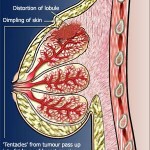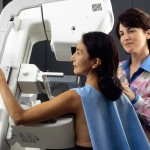The National Cancer Institute estimates that approximately 2.5 million women with a history of breast cancer were alive in January 2006. Most of these individuals were cancer-free, while others still had evidence of cancer and may have been undergoing treatment.
 How has the occurrence of breast cancer changed over time?
 Incidence trends
 Invasive breast cancer
 Â Incidence rates of invasive female breast cancer for all races combined show five distinct phases since 1975, when population-based surveillance of cancer began:
 Incidence rates of invasive female breast cancer for all races combined show five distinct phases since 1975, when population-based surveillance of cancer began:
• Between 1975 and 1980, incidence was essentially constant.
• Between 1980 and 1987, incidence increased by 4.0% per year.
• Between 1987 and 1994, incidence was essentially constant.
• Between 1994 and 1999, incidence rates increased by 1.6% per year.
• Between 1999 and 2006, incidence rates decreased by 2.0% per year.
Much of the long-term underlying increase in incidence may be attributed to changes in reproductive patterns, such as delayed childbearing and having fewer children, which are recognized risk factors for breast cancer. The rapid increase between 1980 and 1987 is due largely to greater use of mammography screening and increased detection of breast cancers too small to be felt. Detecting these tumors earlier has the effect of inflating the incidence rate because tumors are being detected 1 to 3 years before they would have been diagnosed if they continued to grow until symptoms developed. During the uptake of mammography, from 1980 to 1987, incidence rates of smaller tumors (≤ 2.0 cm) more than doubled, while rates of larger tumors (3.0 cm or more) decreased 27%.
The slight increase in overall breast cancer incidence during the later half of the 1990s may reflect increases in the prevalence of mammography screening, rising rates of obesity, and menopausal hormone use. The recent decline in breast cancer incidence is likely due to decreased use of menopausal hormones following the publication of the results of the Women’s Health Initiative randomized trial in 2002, as well as a decrease in mammography screening (thus, detecting fewer cancers earlier). National studies on the prevalence of mammography suggest that since 2000, the percentage of women aged 40 and older who reported having a mammogram within the past 2 years has either decreased slightly or stabilized. The decrease in breast cancer incidence rates due to the lower prevalence of mammography use gives the appearance of a decline in the rate of disease, but in fact reflects underdiagnosis or delayed diagnosis and not a true decrease in disease occurrence.
A sharp decrease in breast cancer incidence rates in the US occurred between 2002 and 2003, particularly among women aged 50-69 years in whom menopausal hormone use is most common. This decrease is likely a result of the rapid drop in hormone use that began in 2002. Similar reversals in breast cancer trends have been observed internationally as well. However, breast cancer incidence rates have remained relatively stable since 2003.
In situ breast cancer
Incidence rates of in situ breast cancer increased rapidly during the 1980s and 1990s, largely because of increased diagnosis as a result of mammography screening. The increase was observed in all age groups, although it was greatest in women aged 50 and older. Since 1999, incidence rates of in situ breast cancer have decreased among women aged 50 and older, but continued to increase in younger women.
The decrease in incidence among women aged 50 and older may reflect the reduction in mammography screening since 2000. There are two main types of in situ breast cancer: ductal carcinoma in situ (DCIS) and lobular carcinoma in situ (LCIS). The majority of in situ breast cancers are DCIS, which accounted for about 80% of cases diagnosed from 2002-2006. DCIS is detected by mammography, and the historically large increase in DCIS incidence was a direct result of mammography’s ability to detect cancers that cannot be felt.
LCIS is much less common than DCIS, accounting for about 12% of female in situ breast cancers diagnosed from 2002-2006. Similar to DCIS, the overall incidence rate of LCIS increased more rapidly than the incidence of invasive breast cancer. This increase was limited to women over the age of 40 and largely to postmenopausal women. Other in situ breast cancers have characteristics of both ductal and lobular carcinomas or have unspecified origins.
 Mortality trends
 The death rate for breast cancer in women has decreased since 1990.
• Between 1975 and 1990, the death rate for all races combined increased by 0.4% annually.
• Between 1990 and 1995, the rate decreased by 1.8% annually.
• Between 1995 and 1998, the rate decreased by 3.3% annually.
• Between 1998 and 2006, the rate decreased by 1.9% annually.
The percentage decline was larger among younger age groups. From 1990-2006, death rates decreased by 3.2% per year among women younger than 50, and by 2.0% per year among women 50 and older. The decline in breast cancer mortality has been attributed to both improvements in breast cancer treatment and early detection. Generally, African American women and women of other racial and ethnic groups have benefited less than white women from these advances. From 1997-2006, female breast cancer death rates declined by 1.9% per year in non-Hispanic whites and Hispanics/Latinas, 1.6% in African Americans, 0.6% per year in Asian Americans/Pacific Islanders, and remained unchanged among American Indian/Alaska Natives.
A striking divergence in long-term breast cancer mortality trends between African American and white women began in the early 1980s; by 2006, death rates were 38% higher in African American than white women.


